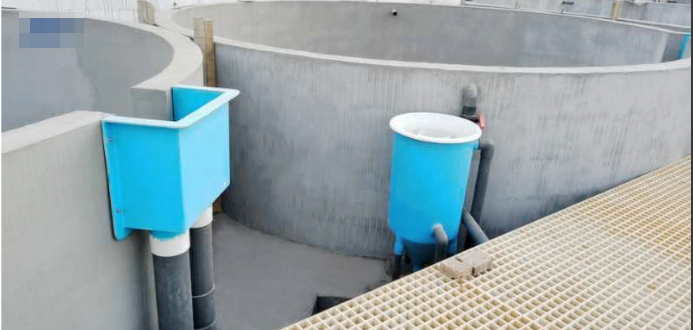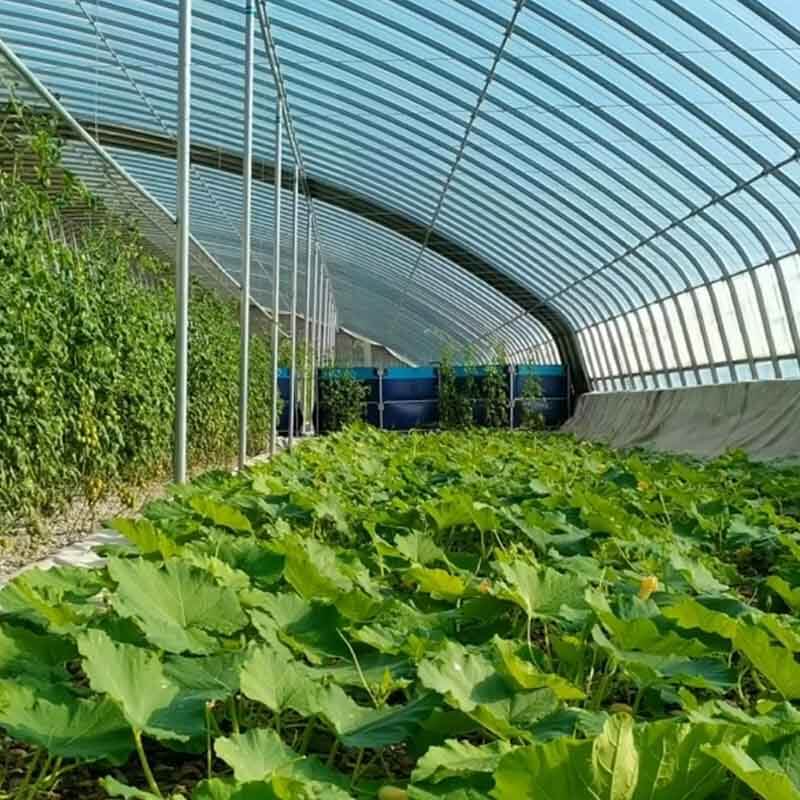Solid Particle Removal Technology (Part 3): Process Parameter Design and Case Studies
-
Parameters for Designing Suspended Particle Removal Processes in Recirculating Aquaculture Systems
- Design Parameters for Vertical Flow Settlers
The Cornell dual row system has been widely used and has achieved good practical results. In aquaculture ponds using the Cornell double row system, 10% to 25% of the water flow enters the vertical flow sedimentation tank through the bottom drainage pipe and is discharged, while the remaining majority of the water flow is discharged through the fish pond side. The use of dual drainage design greatly increases the ability of the bottom to collect pollutants through vertical slow flow drainage. At this low flow rate, the concentration of particulate matter is increased by 10 times compared to the main flow measurement method.

The ratio of the flow rate through the vertical flow sedimentation device to the flow rate entering the side discharge can be calculated based on the cross-sectional area of the bottom sewage pipe of the fish toilet. In general, the pipeline entering the side row is 110, and the pipeline entering the vertical flow settler is 50, so their cross-sectional area ratio is 5:1. That is to say, about 17% of the water flows into the vertical flow settler. Considering that the concentration of suspended particles entering the vertical flow settler is 10 times that entering the side discharge. Based on this calculation, the proportion of suspended particles processed by the vertical flow settler is about 70%. In specific use, the ratio of the pipe diameter entering the side row to the pipe diameter entering the vertical flow settler can be adjusted according to the specific breeding variety and breeding density, in order to achieve the adjustment of the flow rate ratio entering the microfilter and vertical flow settler respectively.
The key indicator determining the vertical flow settler is hydraulic retention time. Hydraulic retention time refers to the average time water stays in a vertical flow settler. Adequate hydraulic retention time is one of the key factors in ensuring sufficient sedimentation of suspended particulate matter. It is related to the volume of the settler and the amount of water processed. In recirculating aquaculture, it is recommended that the hydraulic retention time of the vertical flow settler be at least 30 seconds or more. If the hydraulic retention time is too short, suspended particles may not settle in time and may be taken out of the sedimentation tank; If it is too long, it will increase the size and cost of the equipment.
In design, it is generally based on experience:
The diameter of the vertical flow sedimentation device: a 600mm diameter vertical flow sedimentation device is installed in a 6-meter breeding pool, and an 800mm diameter vertical flow sedimentation device is installed in an 8-meter breeding pool.
Height of vertical flow sedimentation device: 1 meter
Conical angle: 30 degrees
How to transform a vertical flow sedimentation device into a smart vertical flow sedimentation device?
The traditional vertical flow settler can only discharge the sewage inside the vertical flow settler by pulling out the pipe. Usually, pulling once will completely drain the water from the vertical flow sedimentation tank. Due to the large number of recirculating aquaculture ponds, manual extraction is generally only possible 1-2 times a day. However, the residual bait and feces in the vertical flow settler will slowly disintegrate in half an hour, becoming suspended particles that are soluble in water, and then continuously float up, overflowing into the microfilter through the upper part of the vertical flow settler, increasing the burden on the microfilter and protein separator.
Therefore, a smart discharge valve can be installed at the discharge pipe of the vertical flow sedimentation device, which discharges for a few seconds every hour and adopts a small amount of multiple discharges discharge strategy. In this way, residual bait feces can be discharged in a timely manner, reducing the burden on microfiltrations and protein separators. At the same time, a small amount of multiple discharges are very water-saving, greatly reducing the water change rate, not only saving water but also energy consumption.
When choosing a drain valve, it is important to choose an IP68 waterproof valve, otherwise the valve is prone to rusting and causing malfunctions, which can result in unnecessary losses. If it is seawater aquaculture, it is recommended to choose UPVC material to prevent seawater corrosion.
Installing this device on the traditional vertical flow sedimentation device truly upgrades it into a smart vertical flow sedimentation device, achieving intelligent and unmanned operation, not only improving water quality but also saving water and electricity.
2. Parameter design of microfiltration machine
Microfiltration machines are used to remove solid suspended particles of 30-100 microns. The processing capacity of a microfilter refers to the device's ability to pass water. The size of the filter mesh determines the treatment effect, usually choosing 200 mesh. So how should we design the parameters of the microfilter?
Firstly, introduce an engineer's experience data for practical operation:
Excess water volume=volume of aquaculture water/cycle frequency * 1.2
1.2 is safety redundancy, and the cycle frequency refers to how many hours it cycles once. The cycle frequency is generally determined based on different breeding varieties and biological carrying capacity. Taking the cultivation of sea bass in a 1000 cubic meter circulating water body as an example, it is best to set the circulation frequency to once every 2 hours. Therefore, the water passing capacity of the microfilter is: 1000/2 * 1.2=600 tons
In practice, one 600 ton microfilter can be installed, or two 300 ton microfilters can be installed. The advantage of installing two microfiltration machines is that when one machine malfunctions and is repaired, the other microfiltration machine can still work normally. But the price of two small microfiltration machines is higher than the price of one microfiltration machine.
3. Parameter design of protein separator
The protein separator is used to process suspended particles above 30 microns, and its processing capacity is only the amount of excess water per hour. Each protein processor manufacturer's equipment will indicate the hourly water flow rate. Taking the cultivation of sea bass in a 1000 cubic meter circulating water body as an example, the system has a circulation capacity of 600 tons per hour. So you can choose a protein separator with a processing capacity of 600 tons per hour.
2、 Calculate the circulation volume of the circulating water system
In the previous text, we provided an empirical rule for cyclic quantities. Next, we will provide a rigorous derivation and calculation method.
Firstly, we need to determine the amount of Total Suspended Solids (TSS) produced in the system. This can be calculated using the following formula:
RTSS=0.25X maximum daily feeding amount
Next, we will use the following formula to calculate the system circulation based on total suspended particulate matter:
QTSS
Among them, QTSS is the calculated value of system circulation based on TSS, with the unit of m ³/h;
TSSin is the target of circulating water TSS control;
TSSout is the target control concentration of TSS in the effluent of aquaculture ponds, measured in mg/L;
ETSS is the removal efficiency of TSS in the physical filtering process, measured in%;
1000 is the quality conversion factor, which converts mg to g.
3、 Practical Cases
Construct a 1000 cubic meter circular water aquaculture project for sea bass. The technical indicators for project design are as follows:
Breeding density: 50kg/cubic meter
Daily feeding rate: 2%
The target removal rate of the suspended particle system is 70%
The TSS control target for circulating water is 10mg/L
Based on the above indicators, we will calculate the circulation volume of the circulating water system:
Firstly, let's calculate the weight of suspended particulate matter generated each day:
RTSS=0.25X daily maximum feeding amount=60X1000X2% X0.25=12.5kg/day.
According to the analysis above, 70% of solid particles (mainly residual bait feces) will be discharged by the vertical flow settler, so only 30% of suspended particles will enter the circulation system.
Based on this, calculate the circulation volume of the circulating water system:
QTSS =600.96 m³/h
This calculation result indicates that in order to maintain the TSS concentration in the aquaculture pond not exceeding 10 mg/L and under the condition of a suspended particulate matter removal rate of 52%, we need to design a circulation rate of approximately 600m ³/h.
In actual operation, we can adjust the water circulation in the recirculating aquaculture system based on these parameters to ensure that the water quality meets the aquaculture needs. For example, if our TSS concentration exceeds the standard, it indicates two possibilities.
The processing capacity of microfiltration and protein separator equipment is less than 52%
The processing capacity of the vertical flow sedimentation device is less than 70%
Recommended Products
Hot News
-
Is it true that raising fish in high-density canvas fish ponds is more efficient than ordinary ponds?
2024-12-16
-
Advantages of galvanized canvas fish pond
2024-10-14
-
High-density fish farming technology, fish pond cost, canvas fish pond, canvas pond, high-density fish farming
2024-10-12
-
Why choose flowing water high-density aquaculture
2023-11-20















































